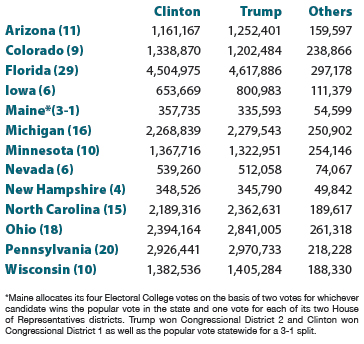

On Thursday, January 12, 2017, the Constitutional Affairs and Parliamentary Studies Unit (CAPSU) held the first of its CAPSU Conversations series on the topic “The American Electoral System and the Election of Donald Trump as the 45th President of the United States”.
The session examined the actual process itself from the Election Day, which is fixed for the first Tuesday following the first Monday in November in a leap year; through the sitting of the Electoral College on the first Monday after the second Wednesday in December; to the counting of the Electoral College ballots by a joint session of Congress under the chairmanship of the Vice President in order to certify the final result on January 6.
The Electoral College allocations for each state are based on the size of their House of Representatives delegation plus two additional votes for each state to correspond to the fact that each state has two senators regardless of size. Since 1961, Washington, DC, the federal capital, has been added to the membership of the Electoral College with the smallest number of votes that can be allocated, namely three.
There are 435 House of Representatives districts and 100 senators, which gives an allocation of 535 votes and when added to the three votes for Washington, DC the total Electoral College allocation is 538. It takes 270 votes in order to become the President.
The popular vote was won by the Democratic Party nominee Hillary Clinton with 65,844,610 votes (48.2%) over the Republican Party nominee Donald Trump with 62,979,636 votes (46.1%), while the Electoral College allocation was won by Trump (306) over Clinton (232). The other candidates combined earned 7,804,213 votes (5.7%) and no Electoral College votes.
The key to Trump’s victory was his win in the so-called “Rust Belt” of Wisconsin (10 Electoral College votes), Michigan (16 Electoral College votes), Ohio (18 Electoral College votes) and Pennsylvania (20 Electoral College votes). Trump’s ability to win those 64 Electoral College votes made all the difference together with victories in some so-called “swing states”.
The results in 13 swing states were as follows:

The session also noted the fact that there were deviations in the final Electoral College vote as some electors did not vote for the candidates to whom they were pledged when the Electoral College met on December 19. Trump emerged with 304 (down from 306) and Clinton emerged with 227 (down from 232).
These votes were confirmed on January 6 in the joint session of Congress and Donald Trump was sworn into office on January 20 as the 45th President of the United States.
Dr. Ghany is Senior Lecturer in Political Science and Coordinator of the Constitutional Affairs and Parliamentary Studies Unit in the Faculty of Social Sciences. |





